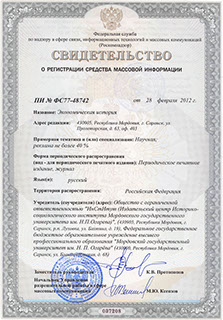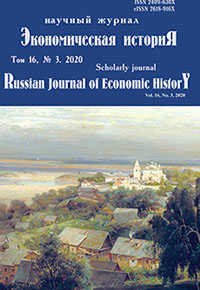Экономическая историЯ
Russian Journal of Economic History
ISSN 2409-630X (Print)
ISSN 2618-916X (Online)
Expert board:
- Scientific Council of RAS on economic history;
- Research and Educational Center «The economic history of Central Russia and the Middle Volga region» of Ogarev Mordovia State University;
- Center of Economic History of Lomonosov Moscow State University
Navigation
Certificate of registration

ISSN 2409-630X (Print), ISSN 2618-916X (Online)
DOI: 10.15507/2409-630X.050.016.202003.286-296
УДК 94(47)08
Daniil S. Zaozerskiy
Laverov Federal Center for Integrated Arctic Research, the Ural Branch of the Russian Academy of Sciences (Arkhangelsk, Russia),
e-mail: d.zaozerskiy@yandex.ru
The Wage System of the Novaya Zemlya and Spitsbergen Trapping Artels in the 19th – Beginning of the 20th century
Introduction. The Arkhangelsk North natural and climatic conditions promoted to develop shipbuilding, fishing, hunting and other activities, for which artels were organizing. The Pomors also united in artels for profitable trapping on Novaya Zemlya and Spitsbergen in the 19th – beginning of the 20th century. The usage of the artel principles of labour organization can be explained by the difficult circumstances of the hunting activities. It was impossible to work by oneself or by a small group of 2–7 trappers. The studying of the Novaya Zemlya and Spitsbergen trapping artels is necessary for further understanding of the process of the Arctic exploration by Russia in the 19th – beginning of the 20th century. The purpose of the article is to study the wage system of the Novaya Zemlya and Spitsbergen trapping artels in the 19th – beginning of the 20th century. Materials and Methods. The materials for this article were archive sources of the Arkhangelsk oblast State archive, published sources on the Novaya Zemlya and Spitsbergen artels and articles in the local periodicals. The historical-systematic and historical-genetic methods were used in the article. Results. During the 19th – beginning of the 20th century the principle when trappers united in artels continued to exist. The main form of the payment was to divide the catch into shares. Discussion and Conclusions. The main difference between artel trapping of people from the Arkhangelsk province districts consisted in terms of sailing to the archipelagoes and the beginning of the hunt. The decrease of number of trappers in artels determined by economic opportunities of the sponsors (the masters). Also, it was determined by decrease of the number of industry animals. Both unfixed (by shares) and fixed wage systems existed in the Novaya Zemlya and Spitsbergen artels. The quantity of shares exceeded the number of artel members. The master defined value of share before the beginning of the hunt. Also, he provided necessary provision and weapons for artel members with both unfixed and fixed wages. The most common way of sharing of catch meant that the master had been earning two thirds of it and the trappers had been earning the rest one third. This way of sharing was used before the beginning of the 20th century.
Keywords: Arctic, Novaya Zemlya, Spitsbergen, sea fishing and hunting, artels, pokrut, wage system.
For citation: Zaozerskiy D. S. The Wage System of the Novaya Zemlya and Spitsbergen Trapping Artels in the 19th – Beginning of the 20th century. Ekonomicheskaya istoriya = Russian Journal of Economic History. 2020; 16(3): 286–296. (In Russ.). DOI: 10.15507/2409-630X.050.016.202003.286-296
© Ogarev Mordovia State University. History and Sociology Institute, 2017
68, Of. 411, Bolshevistskaya St., 430005, The editorial office of the scholarly journal «Russian Journal of Economic History»
Tel.: (8342) 24-25-90; 27-07-11, Fax: (8342) 24-25-90, E-mail: jurnal-econom-hist@isi.mrsu.ru
Designed by A. Napalkov, Email: napalkov@isi.mrsu.ru

